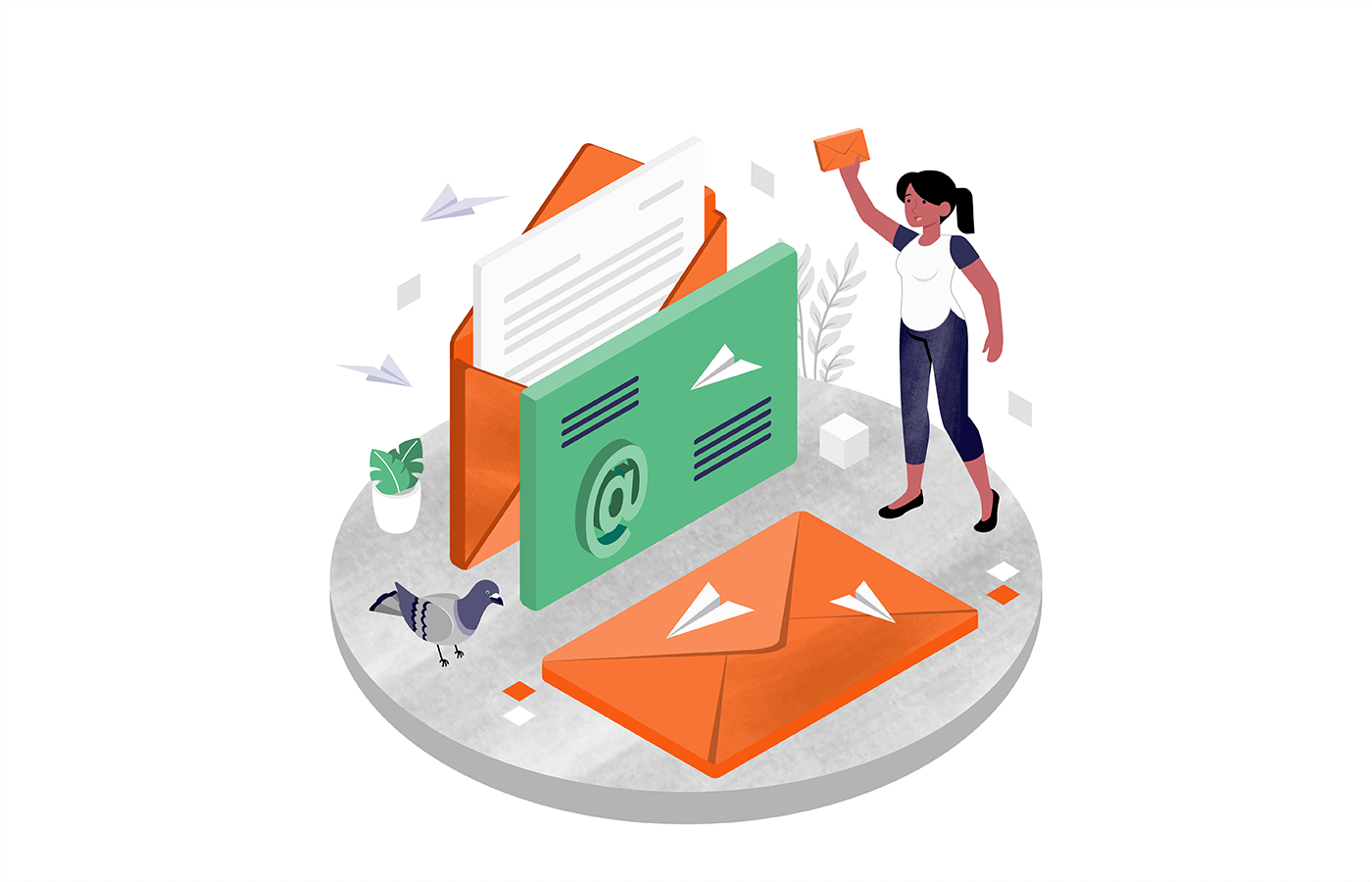You might find this hard to believe, but we were late to start email marketing. We were so focused on building reliable email marketing software for others to send great emails that we neglected our own email marketing.
For a while, it was a messy mix of inconsistent updates. But when we finally took email seriously—starting with small, strategic changes—things transformed fast.
Now, we’re sharing what we learned through this blog. Read on to find out.
16 Email Marketing Strategies to Keep You Ahead
Over the last few years, we tested, tweaked, and learned what works—and now, we’re sharing email marketing best practices that helped us in our efforts. Without further buildup, let’s begin.
1. No One Likes Being Just a Number
Personalization within email is an absolute win-win. It delivers a much-enhanced customer experience. Great. But for business, it drives both higher email engagement and revenues. Test it for yourself to see.
– Gavin Sherry, Head of Deliverability at Bloomreach
Who likes receiving mass, impersonal emails? No one? Thought so! No two subscribers on your list are exactly alike, which is why segmenting your subscribers is so important.
Email segmentation allows you to divide your list into smaller groups based on demographics or user behavior, allowing you to create personalized content that truly resonates.
Instead of generic email blasts, you can tailor email copy, offers, and subject lines to the unique needs of each segment. This means crafting personalized emails that feel more like a recommendation from a friend than a generic catalog.
For truly impactful personalization, go one step further by using customer data like purchase history and user behavior to recommend products and personalize the image’s content within your emails.
This level of personalization leads to greater email engagement and helps build relationships with your subscribers, resulting in more sales, stronger loyalty, and a more meaningful connection with your brand.
For example, realizing that their VIP customers (high or frequent spenders) deserve a little pampering, MODR sent an email inviting them to shop the new collection early.
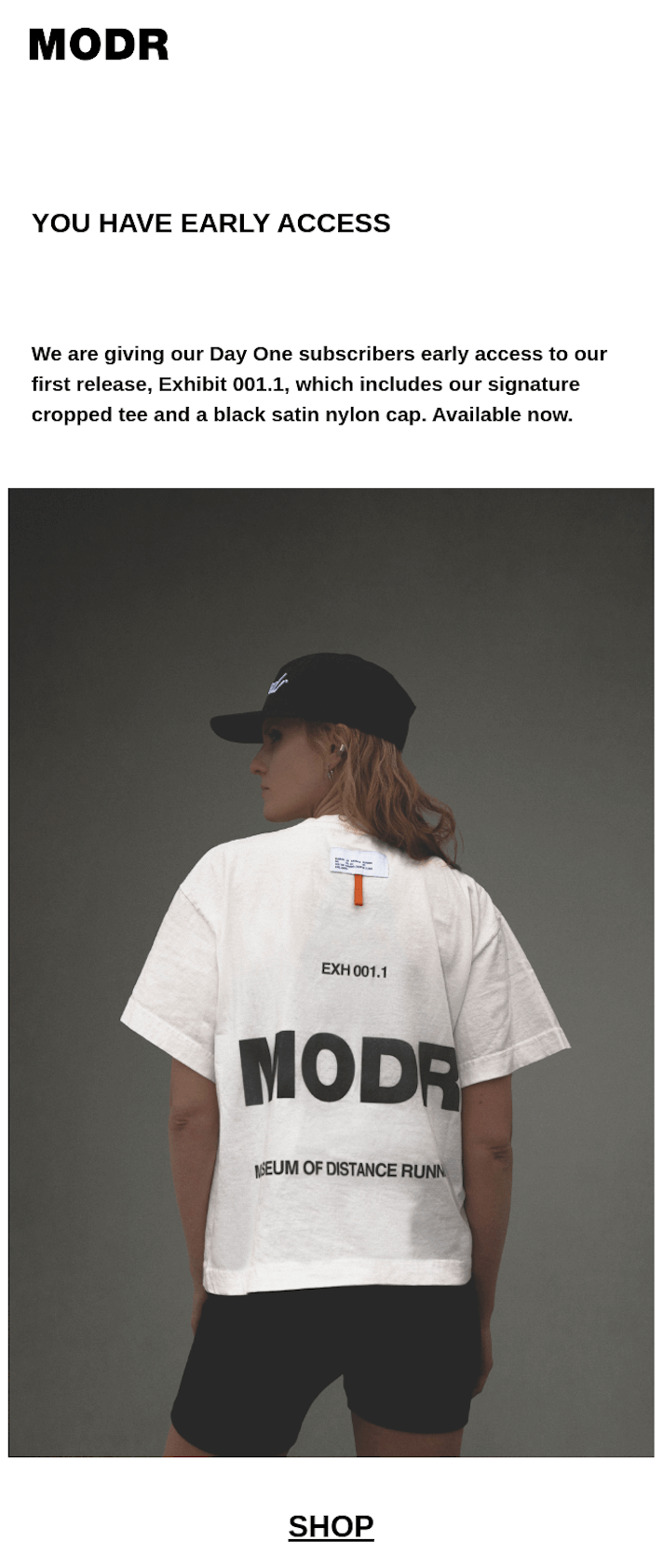
2. Replace Guessing with Data-Driven Decisions
Testing helps avoid assumptions and provides data-backed insights. For instance, testing plain-text versions versus HTML emails can lead to surprising results that challenge initial instincts.
— Michael Alexis, CEO of Team Building
Never plan email marketing campaigns based on assumptions, but numbers. If you make decisions based on instinct rather than data, you’re leaving conversions on the table.
A/B testing provides you with the insights needed to optimize and refine your email marketing strategies. And we’re not the only ones to say this. According to Litmus, brands that A/B test their campaigns register a 37% higher ROI than the ones that don’t.
As you know now, A/B testing (or split testing) helps you compare two versions of an email to see what performs better.
Here are some elements of an email campaign to A/B test:
- Subject line testing. Try an urgency-based subject line vs. a question-based one (Example: “Last Chance: 24 Hours Left!” vs. “Are You Missing Out?”);
- Call-to-action (CTA) variations. Test a “Shop Now” button vs. a “Get Your Discount” button to see which drives more clicks;
- Plain text vs. HTML emails. Some audiences respond better to minimalist emails, while others prefer richly designed email templates.
3. Don’t Leave ‘Em Wondering what to Do Next
You can have the best email campaign in the world, but without a strong call to action, it’s going nowhere. It’s the key to turning interested readers into paying customers.
– Skirmantas Venckus, CMO at Sender
Think of your email CTA as that little push they need to swing by your online store, check out a blog post, or grab a special deal. The CTA is the bridge between interest and action, telling your subscribers exactly what to do next.
Why does a strong CTA matter?
- Using a specific, clear CTA can increase conversion rates by 161%;
- Adding urgency to CTAs, such as limited-time offers, can increase conversion rates by 332%;
- Placing the CTA button at the end of the product landing page can increase conversions by 70%.
Tips to create a high-converting CTA
| Tip | Details | Examples |
| Use action-driven language | Tell readers exactly what to do, instead of a generic ‘Learn More’. | ‘Grab Discount Now’‘Claim Your Free Trial’ ‘Start Now’ |
| Create urgency | Limited-time offers push people to act fast. | ‘Claim Before It’s Gone’‘Grab The Last Chance’ |
| Highlight the benefit | Why should they click? Show the value they’ll get. | ‘Get $50 Off’‘Unlock Success Secrets Now’ |
| Test different CTA styles | A/B test CTA placement, button color, wording, and urgency to see what works best for your audience. | Check below |
Need to see these tips in action? Here’s an example of a great CTA by L’amarue:
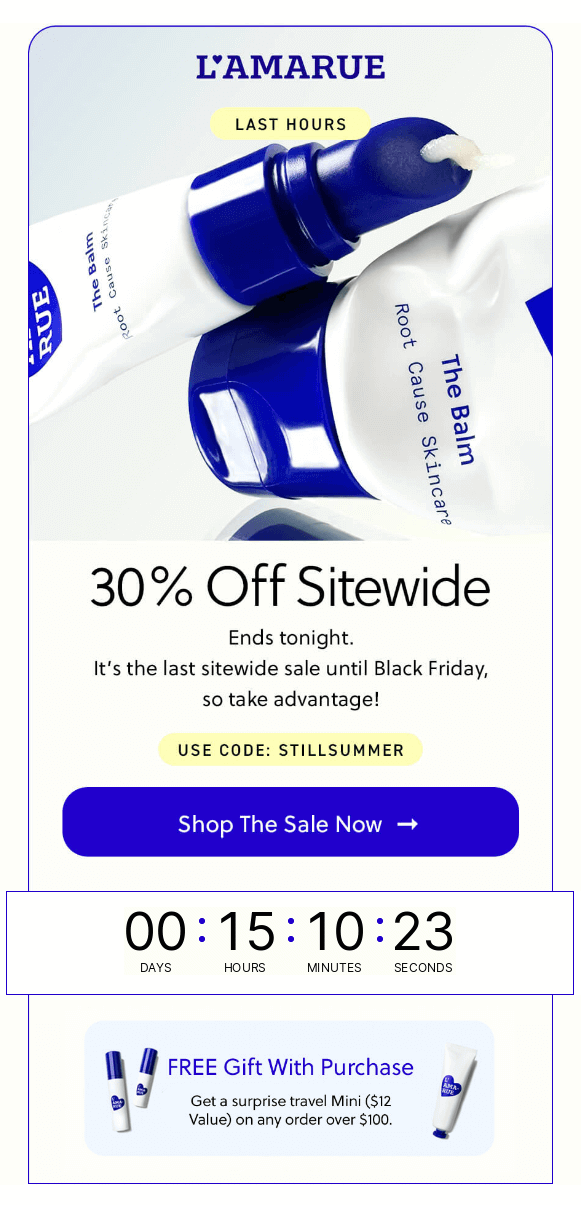
They nailed their CTA ‘Shop the Sale Now’ by making it impossible to ignore. Plus, there’s a countdown timer to depict urgency:
- It’s bold and clear. There’s no confusion about what action to take;
- It creates urgency. Encourages people to act now, not later.
Remember, a great CTA is not an afterthought—it’s the deciding factor in whether your email converts. Make it strong, make it clear, and make it count!
4. Make Your Email Campaigns Shine on Mobile
Ever opened an email on your phone only to see tiny text, images that don’t load properly, or buttons too small to tap? Frustrating, right? That’s exactly why mobile optimization isn’t optional—it’s essential.
More people tend to open emails on their mobile devices rather than desktops. Emails that work well on mobile devices are more likely to engage recipients.
— Eunice Asuncion, Content Marketing Specialist at Web.com
Why mobile-friendly emails matter?
Your audience is on the go. If your emails aren’t easy to read on a mobile screen, they’re not getting read at all. And that’s a huge missed opportunity.
- 81% of people prefer opening emails on their smartphones;
- Mobile-friendly emails have a 15% higher click-through rate;
- 42% of users delete emails that don’t display properly on mobile.
The bottom line? If your emails aren’t easy to read, scroll, and act on from a phone, they won’t convert. Design for mobile first, and your campaigns will perform better.
Email design tips to create mobile-friendly emails:
- Use a responsive design. Your email should automatically adjust to different screen sizes;
- Keep subject lines short. Mobile screens cut off long subject lines. Stick to 30-40 characters;
- Break up text. Huge paragraphs feel overwhelming on a small screen. Use short sentences, bullet points, and plenty of white space to improve readability;
- Make CTAs big and tappable. Buttons should be at least 44 pixels long so they’re easy to click without zooming in;
- Optimize images and loading speed. Compress images to prevent slow load times. A slow email means lost readers.
Grab Sender’s responsive email templates and create a beautiful emails in minutes that look sharp on any device.
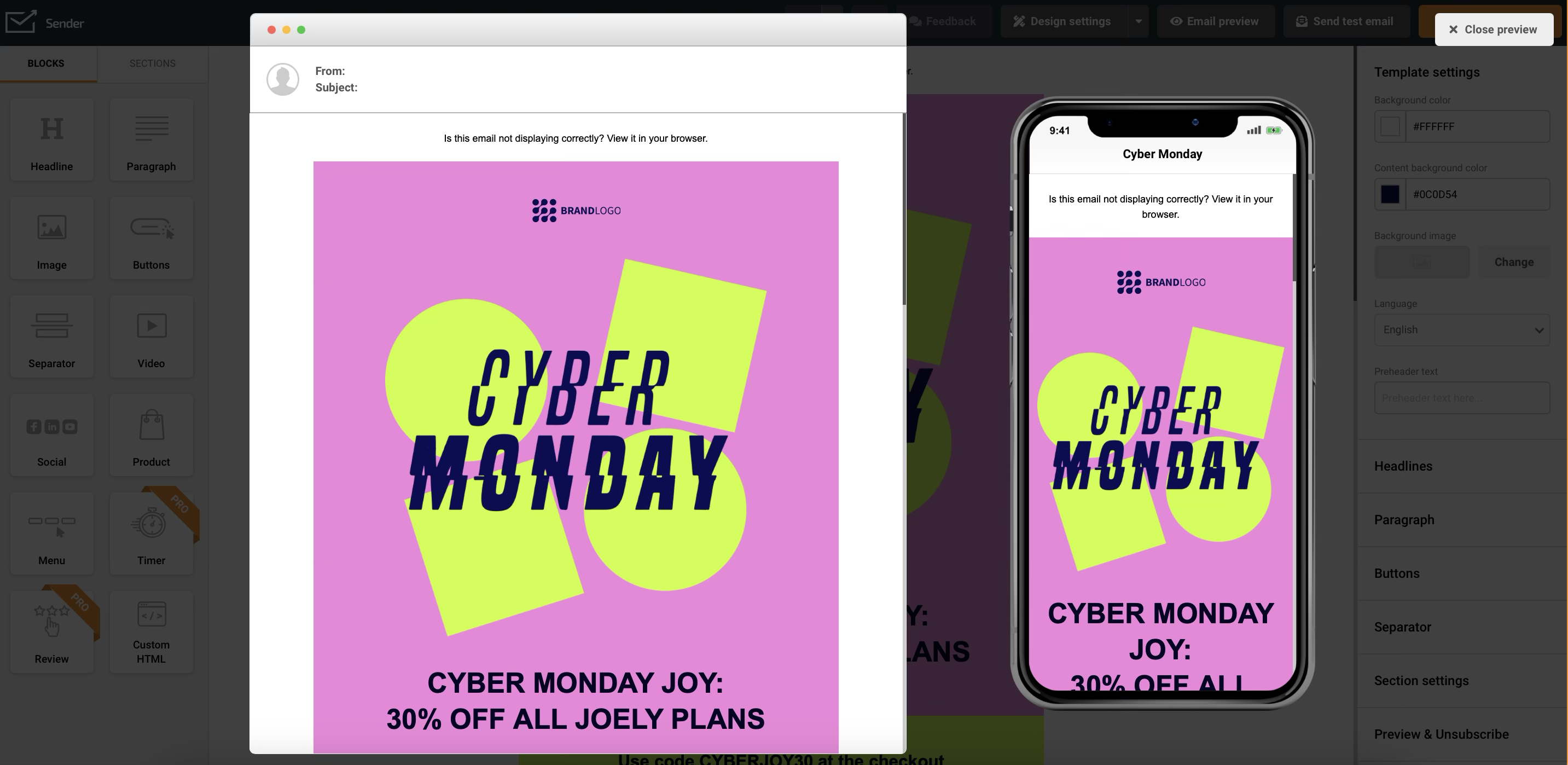
5. Let the Automation Do the Heavy Lifting
Email automation is a powerful tool that allows businesses to communicate at scale, always responding with the right message at the right time, making sure it’s relevant to each recipient.
– Dave Hitchins, Senior Content Marketing Specialist at Infobip
Manually sending every email is time-consuming, inconsistent, and impossible to scale. That’s why smart marketers let automation handle the heavy lifting.
From welcome sequences to abandoned cart reminders, automated emails ensure every subscriber gets the right message at the perfect time—without extra effort on your end.
Here’s an example of an automated email by Cymbiotika:
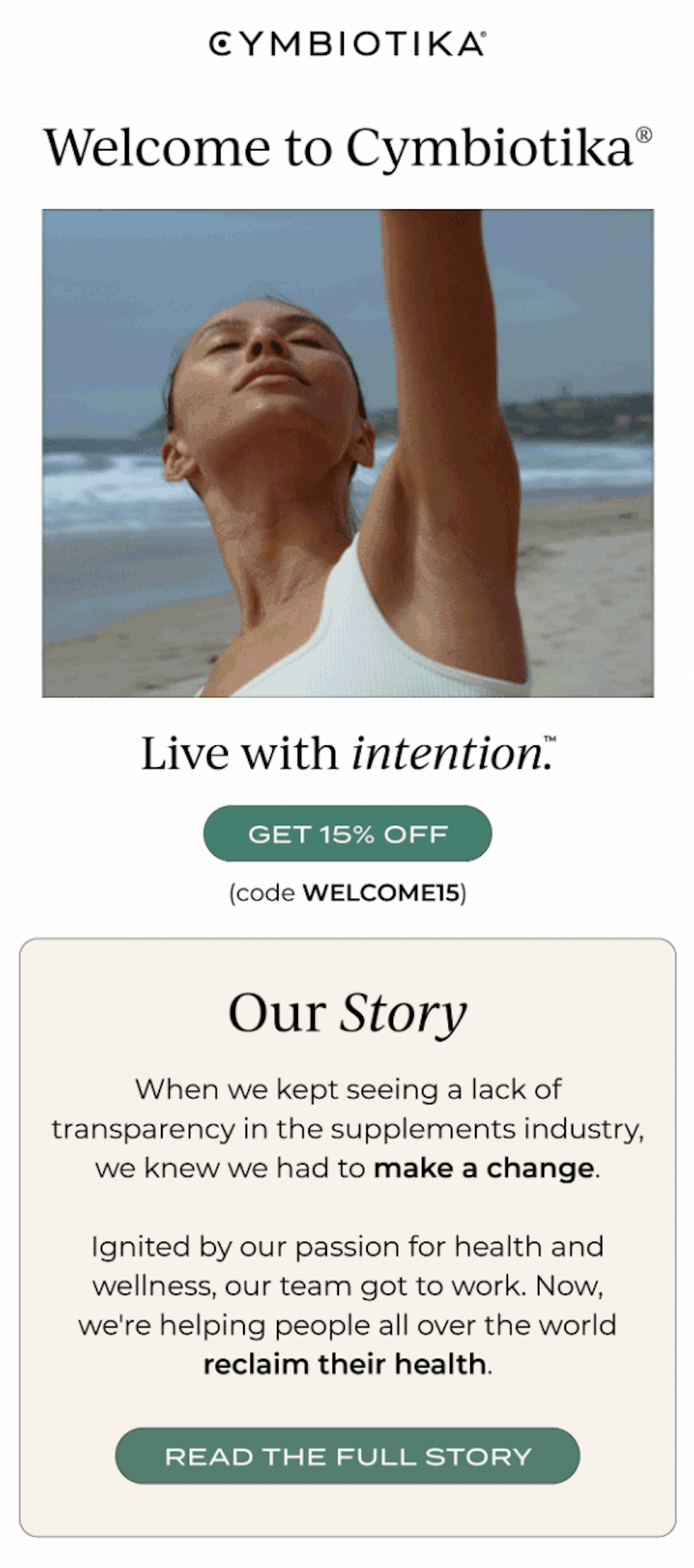
The email greets new subscribers with a warm welcome email containing a welcome coupon code and the brand’s story. This is a great way to introduce the brand and intrigue a new subscriber to buy something.
Why is email automation useful?
- Automated emails generate 320% more revenue than non-automated emails;
- Businesses that use automation see a 451% increase in qualified leads;
- Personalized automated campaigns increase conversion rates by 60% compared to traditional campaigns.
Email automation works while you sleep, making sure no lead or customer slips through the cracks. Set it up using an automation-first email service provider once, and let it drive results on autopilot.
Here are some automation ideas to help you get started:
- Set up a welcome series. Greet new subscribers with a sequence of emails that introduce them to your brand and offer value;
- Use abandoned cart emails. Recover lost sales by reminding shoppers about items they left behind;
- Nurture leads with drip campaigns. Gradually educate and build trust with potential customers before pushing for a sale.
6. Cut Off the Uninterested Ones
A clean email list is vital for avoiding spam complaints and improving deliverability and engagement. Regularly remove inactive subscribers to keep your list optimized.
– Andrus Purde, Co-Founder of Outfunnel
Before we became serious about email marketing, our email list was filled with unengaged subscribers who rarely opened our emails.
But once we started re-engaging inactive subscribers and removing unengaged ones, the same email campaigns got better results. Plus, our sender reputation improved.
Here’s how you keep your email list healthy:
- Use double opt-in to confirm that people really want to subscribe and prevent those pesky fake sign-ups;
- Keep an eye on user behavior and identify any unengaged subscribers (who haven’t opened or clicked your emails in a while);
- Send out some fun re-engagement campaigns to try and win back those inactive subscribers;
- Make it super easy for people to unsubscribe if they’re not interested anymore.
7. The Psychology of Timing
Many email marketers we’ve met obsess over finding the “best time to send emails“.
But the right timing isn’t just about data. Rather, it’s about understanding human behavior and daily routines.
The key to increasing email open rates, audience engagement, and conversions is knowing when your audience is most receptive to your message.
Here’s why timing matters in email marketing:
Every email competes for attention in a crowded inbox.
People don’t engage with emails just because they see them—they engage when their mental state aligns with the message. Understanding behavioral patterns helps you send emails when people are most likely to act.
Timing strategies based on human behavior
| Timing | Psychological reasoning | Best for |
| Early Morning (6–9 AM) – Setting the Tone for the Day | People check their inbox first thing in the morning, often while still in bed. Emails that land here should be light, digestible, and informative. | Newsletters, daily roundups, inspirational content, or updates for the upcoming day. |
| Mid-Morning Focus Shift (10–11 AM) – Seeking distractions | After settling into work, people take mental breaks between tasks and check emails. This is a great engagement window as they’re looking for light reads and useful insights. | Productivity tools, educational emails, value-packed content, or exclusive data. |
| Lunchtime (12–1 PM) – Micro-break engagement | During lunch, people scroll their phones. They’re mentally disengaged from work but still active online. | Shopping promotions, flash sales, “bingeable” content, or social engagement emails. |
| Afternoon Slump (2–3 PM) – Brain is looking for a reset | Energy levels drop, and people take short breaks to recharge. This is a great time for entertainment, engaging content, or softer sales messages. | Video content, brand storytelling emails, blog promotions, or discount reminders. |
| Evening Wind-Down (7–9 PM) – Decision-making time | People relax after work and finally have time to think about personal decisions—whether that’s booking a trip, making a purchase, or signing up for something. | High-ticket offers, webinars, and purchase-driven emails with compelling CTAs. |
| Late-night browsing (10 PM–12 AM) – Impulse zone | Scrolling through smartphones at night is often impulsive, with people more likely to click but less likely to take major actions. | Exclusive offers, wishlist reminders, or pre-launch teasers. |
As you see, there are multiple opportunities during the day to engage your subscribers. Pair it up with industry data on the best times to send an email, and you’ll see better engagement in your campaigns.
Also, here are some useful tips:
- A/B test different time slots. Don’t rely just on industry data about the “best times”. Find what works for your specific audience;
- Segment based on behavior. Track when users open past emails and send them at their preferred time;
- Leverage automation. Use time zone detection to ensure emails hit inboxes at optimal moments.
The key takeaway? The “best time to send emails” is different for every audience. But by understanding when people naturally engage, you can send emails at the right time, not just at the right moment.
8. Emotional Copy Tied to Specific Personas
If you want to succeed with email marketing, you need to understand that people don’t just buy from your emails because they look good—they engage because they feel something.
The most effective email marketing speaks directly to a person’s emotions, values, and decision-making triggers. However, not all audiences respond the same way. That’s where persona-driven emotional copy comes in.
How do different people respond to emotional triggers?
| Customer profile | What works? | Example |
| Gen Z (Ages 18–24) – Short, Punchy & Trend-Driven | Humor, memes, and conversational tone. | “This deal slaps. But only for 24 hours 👀” |
| Millennials (Ages 25–40) – Humor & Social Consciousness | Sarcasm, memes, relatability, and purpose-driven messaging. | “Saving the planet AND 20% on your next order? Yes, please!” |
| Gen X (Ages 41–55) – Reliability & Efficiency | Straightforward, results-driven language with proof points. | “No gimmicks. Just the tools you need—at 30% off.” |
| Baby Boomers (Ages 56+) – Nostalgia & Trust | Familiarity, storytelling, and exclusivity. | “The classic [product name], just like you remember—but better.” |
| Engaged Online Shoppers – FOMO & Urgency | Scarcity, exclusivity, and social proof. | “Only 3 left in stock—grab yours before they’re gone!” |
| B2B Decision Makers – Logic & Value | Data-driven reasoning, credibility, and time savings. | “Boost productivity by 45% with [solution]. Here’s how.” |
Email marketing content tips to create emotional angles:
- Match tone to audience expectations. Use humor, urgency, or storytelling based on who you’re talking to;
- Tap into pain points. Address real frustrations and offer relevant solutions that make their lives easier;
- Use an emotional hook in subject lines. Make them feel curious, excited, or urgent;
- Test emotional triggers. Run A/B tests to see what resonates most.
9. Subject Lines that Hook from the Start
Treat your email subject line like the title of a book. You want to grab attention, but also make sure it aligns with the content.
– Beau Bawab, Director of Marketing at Beau B Content
You can often predict the success of email marketing campaigns by looking at the subject line. The subject line determines whether your message gets opened or not.
In fact, 64% of recipients decide to open or ignore emails based on their subject lines alone. That’s a good reason to test your subject lines before you hit send.
Here are some more statistics that show why subject lines matter:
- A/B testing your subject lines can drive up to 28% higher ROI;
- Email subject lines with less than 10 characters register the highest open rate at 58%. The second highest open rate is for subject lines between 50-59 characters.
- 71% of marketers believe that email subject lines are critical in building rapport with new customers.
Clearly, subject lines are critical to the success of your campaign. So, how do you make your subject lines better? Here are some tips:
- Keep your subject lines concise – aim for up to 50 characters to ensure they display correctly on various devices;
- Create a sense of urgency or exclusivity with words like “limited-time offer”, “exclusive access”, or “don’t miss out”;
- Use subscriber data to personalize your subject lines.
While we’re on the topic of subject lines, another thing that gets ignored but should be optimized is the email preheader.
Email preheader is a short snippet of text that follows your subject line in many email clients, and if you don’t write one yourself, your recipients might see something generic like “View this email in your browser” – not exactly enticing, right?

Use the preheader to create a compelling preview of your email’s content, like above, enticing readers to open up and explore further.
Here’s how:
- Use the preheader to build on your subject line and provide more context;
- Don’t repeat what you’ve already said in the subject line;
- Communicate the benefit the recipient will receive by opening the email;
- Aim for around 50-130 characters.
By mastering elements of your subject line, you can dramatically increase your email open rates and set the stage for successful campaigns, just like Aura Bora did.
Their email always pops out in our inbox due to its recognizability; the subject line is clear and compelling, while the preheader creates a sense of FOMO (Fear of missing out).

10. Treat them with Valuable Content
Email marketing is not about sending emails. It’s about sending valuable emails.
– Joanna Wiebe, Conversion copywriter at Copyhackers
You won’t get far if your email marketing strategies prioritize sending one promotional email after another. Bombarding your subscribers with constant sales pitches is a surefire way to drive them straight to the unsubscribe button.
Instead, focus on providing relevant content that educates, entertains, or informs your audience. This builds trust, establishes your expertise, and positions you as a helpful resource, making subscribers more receptive to your promotional messages when they arrive.
Here are some content tips to make your emails shine:
- Understand your audience. What are their pain points? What are they interested in? Tailor your content to their specific needs and preferences;
- Provide solutions and insights. Offer helpful advice, actionable tips, or exclusive information valuable to your subscribers;
- Experiment with different formats, such as videos, infographics, or curated content lists, to keep your emails fresh and engaging.
- Use storytelling. Connect with your audience emotionally by sharing relatable stories or case studies.
- Track your numbers. Pay attention to key email marketing metrics to understand what content resonates best with your audience and learn from it.
Everlywell is great at providing valuable content to its audience, going as far as inviting a doctor to collaborate on its newsletter.
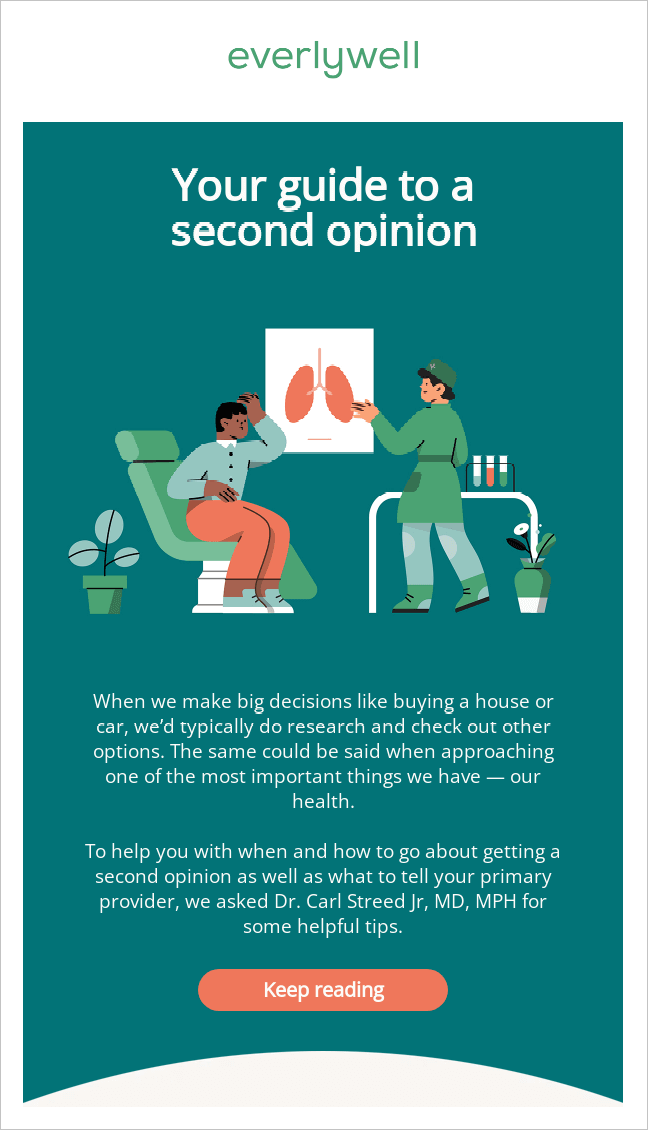
11. Reverse Personalization
Personalization isn’t just about adding a first name to an email—it’s about creating real connections.
But what if, instead of just tailoring emails to customers, you flipped the script and made your brand feel more human?
People connect with people, not faceless corporations—so the more relatable and transparent your brand appears, the stronger your email engagement will be.
Why does reverse personalization work?
- Consumers are 80% more likely to purchase from brands that share personal stories and experiences;
- Emails featuring video content like behind-the-scenes have a 19% higher open rate.
Reverse personalization works because it taps into emotional psychology. When you show your company’s values, team, or behind-the-scenes moments, subscribers feel like they’re part of the journey.
The psychology behind reverse personalization:
- The parasocial effect. When brands share personal stories, consumers who weren’t aware before, feel emotionally invested, like they’re part of an inside circle;
- The principle of reciprocity. When you reveal your personal side and ask something, people feel more connected and are more likely to return the favor by engaging;
- Transparency builds loyalty. Showing transparency builds brand loyalty. Customers prefer brands that feel real, approachable, and human.
Ideas for implementing reverse personalization
| Idea | Explanation | Example |
| Plan a “Here’s what we’ve been up to” email. | Share what’s happening inside your brand. Whether it’s a product update, a milestone, or a team highlight, giving subscribers a peek behind the curtain fosters trust and connection | “Big month at [Your Brand]! Here’s what we’re working on—plus a sneak peek at something exciting.” |
| Showcase customer stories & real experiences. | Instead of generic testimonials, highlight real customer journeys, team experiences, or personal anecdotes that connect on an emotional level | “Meet Alex, a longtime customer who just hit a major milestone using [Your Product].” |
| Use a friendly and conversational tone | Write like you would speak to a friend. Emails that sound genuine and casual feel more relatable and get better engagement | “Hey [Name], we’ve been working on something exciting—want a sneak peek?” |
12. Speak with, not at Your Audience
Spending time getting to know your customers is the make-or-break factor for successful marketing… If the message isn’t relevant to them, they won’t be interested.
– Gessica Lomonte, EMEA e-tail marketing manager at Western Digital
I’ve seen many email marketing strategies fall flat; more often than not, they lacked connection with the audience. You wouldn’t talk to a teenager as you would to a CEO, right? The same is true for email.
Only when you understand your subscribers—their needs, pain points, and aspirations—can you create messages that reach them at a personal level.
Here’s how you get to know your audience:
- Analyze your existing data. Examine your website analytics, social media insights, and past email campaign performance to see what interests and engages your audience;
- Create detailed buyer personas. Create fictional representations of your ideal customers, including their demographics, job titles, goals, and challenges;
- Segment your email list. Divide your subscribers into smaller groups based on shared characteristics and send them targeted content;
- Pay attention to email engagement. Track key metrics like open rates, click-through rates, and unsubscribe rates to understand how effective your campaigns are;
- Use surveys and polls. Gather direct feedback from your subscribers on their wants and needs;
- Don’t forget about accessibility. Always include alt text for images in your emails to ensure accessibility for everyone.
13. Go Beyond Email Marketing
If social media is the cocktail party, then email marketing is the ‘meet up for coffee.’ The original 1-to-1 channel.
– Erik Harbison, Chief Marketing Officer at AWeber
One of the more underestimated tips for email marketing? Don’t do email marketing alone! As powerful as email is, it’s not a solo actor.
Think about your own brand experiences. You know and love many brands, and you interact with them on their websites, on social media, and maybe even through ads or live events.
To truly connect with your audience and drive the results you’re looking for in your marketing, you have to think multi-channel. Use email marketing platforms with omnichannel support, like Sender.
Take these ideas:
- Mention your email list on your social media channels and share an excerpt from the email, inviting followers to subscribe;
- Include social sharing buttons in your emails to let your subscribers grow your reach organically;
- Run omnichannel contests and giveaways. For example, promote your social media contest via email;
- Repurpose your email content across other channels. For instance, convert your newsletters into blog posts or social media status updates.
14. Don’t Stop at One Campaign
Investments in greater email marketing sophistication often lead to even higher returns, not diminishing returns.
– Chad White, author of Email Marketing Rules
Last but not least, in my basket of tips for email marketing – don’t forget the big picture. Too many people treat email marketing like a sprint. They blast out a campaign, and then… crickets.
Yet, successful email marketing campaigns are more like a marathon. It’s about building relationships, nurturing leads, and consistently providing value over time.
Think long-term. Don’t just focus on the immediate conversion. Focus on building a loyal audience that will stick with you for the long haul through a sustained, strategic approach.
15. Psychology of “Micro-Commitments”
Asking someone to buy now in your first email is like proposing marriage on the first date—it’s too much, too soon. Instead of pushing for big commitments right away, guide your audience through small, low-friction actions that gradually lead to conversions.
Each small action—clicking a link, answering a poll, or downloading a freebie—builds psychological investment in the next step.
Micro-commitments work because they trigger the foot-in-the-door effect—a psychological principle where people are more likely to agree to a bigger request after saying “yes” to a smaller one.
The psychology behind micro-commitments:
- The commitment-consistency principle. Once people start taking small steps, they’re more likely to continue taking related actions;
- Loss aversion. If someone has engaged once, they feel a subtle loss if they don’t continue the process;
- Gradual escalation reduces resistance. Low-friction steps feel natural and don’t trigger decision fatigue.
How to use micro-commitments in email marketing?
- Start with curiosity-driven, low-commitment actions. Instead of asking for a purchase immediately, get subscribers to engage first;
✉️ Example: “Click to reveal your special offer” or “Take this 10-second quiz to find your perfect product match.” - Use interactive elements to drive engagement. Polls, surveys, and quizzes make subscribers actively participate, increasing their investment;
✉️ Example: “Which [product type] fits you best? Tap to vote!” - Progressively increase commitment over time. Follow up with a second email that builds on the previous engagement, leading toward a final purchase.
✉️ Example: If they clicked a “See the offer” button in Email #1, Email #2 could say: “Your exclusive discount is waiting—claim it now!”
Start small and guide subscribers through a series of easy, engaging actions before pushing for a purchase. Remember, it’s a psychological sales technique that works.
16. Behavioral Triggers in Action
Imagine walking into a store, checking out a product, and then leaving—only to receive a perfectly timed message later, offering you a discount on that exact item. That’s the power of behavioral triggers in email marketing.
Instead of sending one-size-fits-all emails, behavioral triggers deliver the right message at the right moment, based on real user actions.
Automated campaigns based on behavioral triggers work really well to improve conversions. Here’s some proof:
- Triggered emails with the help of email marketing tools see 70.5% higher open rates and 152% higher CTR than standard emails;
- 50% of cart abandoners who open the triggered mail and click on a link end up buying the product;
- Segmenting your audience based on behavior and sending targeted emails can increase revenue by up to 760%.
Here are some examples of behavioral campaigns that work:
- Cart abandonment emails. If a subscriber adds something to their cart but doesn’t check out, follow up with a reminder or discount. For example, “Still thinking about it? Grab 10% off before it’s gone!”;
- Engagement-based sequences. If a subscriber clicks on a link about email marketing templates, send a follow-up email with your top-performing templates or an exclusive guide. For example, “Loved our email template tips? Here’s a free email marketing guide with even more insider tricks!”;
- Re-engagement emails. If someone hasn’t opened an email in 30+ days, trigger a win-back email with a fresh offer or reminder. For example, “Hey, we miss you! Here’s a special 20% off just for you”;
- Post-purchase follow-ups. After a customer buys, send an email thanking them and suggesting complementary products or resources. A gratitude email that thanks and tells them how to get most of their product can be a great relationship starter.
Need more inspiration? Here are 16 email drip campaign examples for diverse marketing needs.
17. Gamified Signup Forms
Most signup forms are boring—”Enter your email to subscribe”. But what if signing up felt like a game instead of a chore? Gamification is one of the most rewarding list building strategies in 2025.
It taps into our natural desire for rewards and competition, increasing the chances of an email signup. That’s because people are 52% more likely to engage with interactive content than a static offer.
That’s not the only insight. Gamification elements on your website can increase the visitor browsing time by 30%.
Instead of a plain opt-in form, turn the signup process into an interactive experience. Think about adding a surprise incentive, like spinning the wheel for extra discounts, freebies, or an exclusive gift. Here’s a great example:
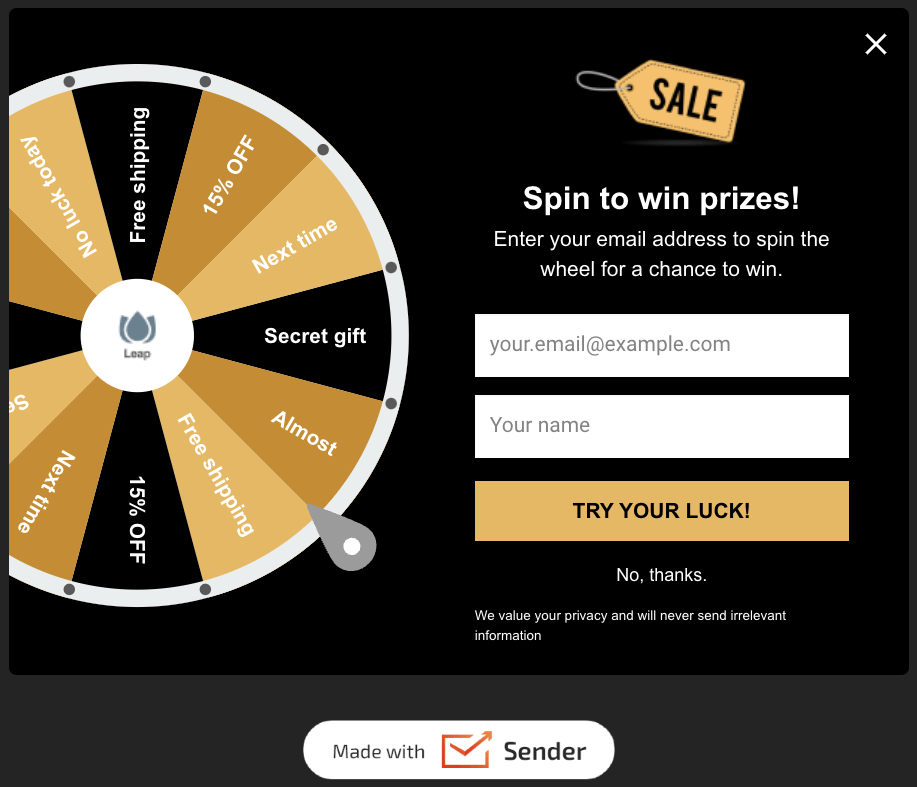
The psychology behind gamification:
- Instant gratification. People love immediate rewards, making them more likely to sign up;
- Loss aversion. If they feel they might miss out on a great deal, they’re more likely to engage;
- Interactivity increases engagement. Games trigger curiosity and excitement, making users more interested.
Now that you know that adding an element of fun, excitement, and reward can boost your sign up rate, here are some ideas:
- Spin-the-wheel opt-ins. Users enter their email to “spin” for a chance to win discounts, freebies, or exclusive deals;
- Scratch & reveal offers. Let users “scratch” a digital card to uncover their prize — a special discount, or a freebie;
- Personality quizzes for signup. Instead of a basic opt-in, guide users through a fun quiz that leads to a tailored offer;
- Countdown challenges. Create urgency by offering limited-time challenges that require email signup, like a limited-time, 48-hour VIP giveaway that requires them to sign up.
The possibilities are endless. Tap into your inner child to think of a game that you wish to play and integrate into your website.
